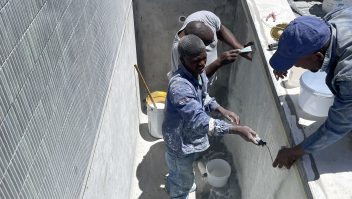Keeping your swimming pool properly sanitised is essential for a safe and enjoyable swim. Chlorine is the most common sanitiser used in South African pools. However, adding too much or too little can cause water quality issues or skin irritation. Our Pool Chlorine Calculator makes it easy to calculate the right amount of chlorine based on your pool volume and current chlorine levels.
Why Chlorine Levels Matter
Chlorine kills bacteria, algae, and harmful contaminants in the water. The ideal free chlorine level in your pool should be between 1 and 3 ppm (parts per million).
- Low chlorine (<1 ppm): Risk of algae, bacteria, and cloudy water
- High chlorine (>3 ppm): May cause eye and skin irritation, and a strong chlorine smell
How to Use the Pool Chlorine Calculator
You’ll need:
- Your pool size in litres
- Current chlorine reading
- Desired chlorine level
- Type of chlorine (liquid, granules, tablets, or salt)
Chlorine Dosage Guidelines:
For a 50,000L pool:
- To raise chlorine by 1 ppm:
- Use 170g of granular chlorine
- Or 500 ml of liquid chlorine (12.5% strength)
Note: Always read the product label for exact concentrations.
How to Add Chlorine Safely
- Step 1: Test your pool water using a test strip or digital meter
- Step 2: Input your results into the Pool Chlorine Calculator
- Step 3: Add chlorine gradually to the pool, preferably in the evening
- Step 4: Let the pump run for several hours before retesting
Maintenance Tip
Chlorine levels fluctuate due to sunlight, bather load, and rain. Use stabiliser (cyanuric acid) to protect chlorine from UV degradation, and test chlorine levels daily in summer.
Internal Links
- Pool Stabilizer Calculator: How Much to Add?
- Pool Shock Calculator: How Much Shock Do You Need?
- How to Maintain Your Pool
External Links
FAQ Section
1. How often should I add chlorine to my pool?
This depends on the type of chlorine used and environmental conditions. Typically, daily or every second day in summer is ideal.
2. Can I swim right after adding chlorine?
Wait until chlorine levels return to the safe range of 1–3 ppm. This can take 2–4 hours depending on the dosage.
3. What type of chlorine is best for home pools?
Granular chlorine is common for manual dosing, while salt chlorinators are popular for automation and gentler water.
4. What happens if I add too much chlorine?
High chlorine can cause skin and eye irritation, bleach pool liners, and damage equipment. Always test before and after adding.
5. Can I use the same calculator for saltwater pools?
Yes, if you’re manually dosing with chlorine. For salt systems, use a Pool Salt Calculator instead.
With our Pool Chlorine Calculator, you can confidently maintain safe water conditions and avoid the guesswork. Whether you’re adding chlorine manually or using a salt chlorinator, balancing your sanitiser levels is key. If you’re in Cape Town or the Western Cape and need help with water balancing, contact Pools Reno for expert services and support.



